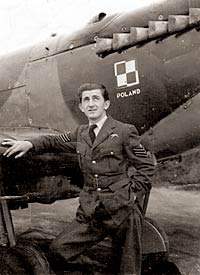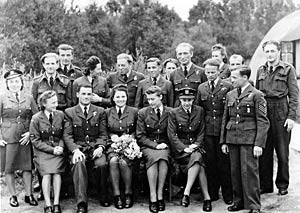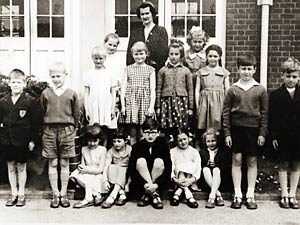
The invasion of Poland in 1939 by the German Third Reich sparked off the Second World War which continued over the next five years, finally ending on VE Day 8 May 1945. During these dark years the people of Poland were under the control of the Germans and Russians as a result of the two countries' Non-aggression Pact signed on 23 August 1939, which agreed to divide Eastern Europe into spheres of influence. Later as the Russians, having changed allegiances to the allies because of Germany’s aggression and invasion in June 1941, advanced towards Germany, the full impact of the Yalta conference held between 4 and 11 February 1945 (between Britain’s Churchill, Russia’s Stalin and USA’s Roosevelt) became known; that Poland was to be included within the Soviet zone.

Ryszard Zielinski, a pilot in the Polish Squadron in the Royal Air Force, in front of his Spitfire plane (image courtesy of SPS Polish Heritage Project).
Many young Polish men and women had fled Poland wishing to fight alongside the allies. Their routes of escape were through Scandinavia, the Baltic States, Hungary and Romania, finally reassembling in France to continue their air war which had been cut short as their small air force was overwhelmed by the German invasion of 1939. It was here that General Wladyslaw Sikorski, once Prime Minister of Poland, was able to reassert his authority and the survival of the air force enabled the exiled Polish government to participate in the military decision making process of the allies. However, the French were less than happy to have the Polish air force personnel assembling in camps at Salon, Bron and Le Bourget. When France was itself overrun by the Germans in the spring of 1940 it became apparent to the Poles that in order to continue their war they had to escape to Britain, leaving in boats from ports such as Marseille and Bordeaux.
The Polish air force can be traced back to World War One and by 1921 there were twenty squadrons. Sikorski, then Minister for Defence began a modernisation process which was cut short when he was relieved of his post after a coup d’etat. The air force was an important sector of the Polish military and so for the exiled Polish air force it was important to integrate its command structure with the RAF but at the same time retain their identity. Sikorski and his officers came to an agreement with the British that fourteen Polish squadrons would operate from Britain which was the highest of any of the free fighting forces helping the allies. Sikorski died in a plane crash under mysterious circumstances in July 1943.
The following statement of Wanda Szuwalska shows how determined they were: “After being allowed to leave the harsh life in Siberia we travelled through Tashkent to Persia where I joined the Polish Army. In 1943, while I was in the Middle East, I was recruited into the Polish Squadron within the RAF. I served on the air control tower until 1945.”
Others were not so fortunate and were forcibly taken by the Russians to Siberia. Most of the people who went to Siberia were from the Eastern borders, known as Kresy. Before the Second World War, this area had belonged to Poland and many of the Poles living there had been given land as a reward for fighting in the First World War and against the Bolsheviks in the 1920s. In February 1940 the Soviet Union began to deport Poles to exile in Siberia. It was an official Soviet policy which targeted over a million Polish citizens and was the first of four major deportations; in February, Polish military settlers, policemen and foresters; In April families of officers imprisoned in the Soviet Union and Poland in hiding and abroad; June, refugees from German occupied Poland who had not accepted Soviet passports and in June 1941 Polish citizens from the Baltic states and those missed in earlier deportations. (see the article in the Holocaust Encyclopedia for more information on German-Soviet pacts). The Soviet Secret Police (NKVD) would arrive at the homes of the Poles in the middle of the night and gave them just a short time to gather their belongings before they were taken to a train and loaded into cattle trucks. And so began their long journey to Siberia which could take up to several weeks. For those lucky enough to escape from Siberia this was one of the most important routes of the Polish people to the UK, some escaped through Romania, others from German P.O.W. camps and some were forced to join the German army, which they subsequently managed to escape from. Many Poles were forced to stay in the Soviet Union, the fate of those deported, however, improved in mid- 1942 after an amnesty for Polish Citizens living in the Soviet Union was declared shortly after the attack on the Soviet Union by Germany on 22 June 1941. Albert Anders was released by the Soviets with the aim of forming a Polish Army to fight alongside the Red Army. Continued friction with the Soviets over political issues as well as shortages of weapons, food and clothing, led to the eventual exodus of Anders' men – known as the Anders Army – together with a sizeable contingent of Polish civilians via the Persian Corridor into Iran, Iraq and Palestine. Here, Anders formed and led the 2nd Polish Corps, fighting alongside the Western Allies, while agitating for the release of Polish nationals still in the Soviet Union. A considerable number of Polish orphans were sent to refugee camps in India, which was considered the best option for their survival.

Wedding party of Wanda Gaweł-Szuwalska and Jan Gawel, 300 Bomber Squadron, RAF Station, Faldingworth at Easter 1945 (image courtesy of SPS Polish Heritage Project).
Testament to this is shown by Zbyszek Luczynski: “My father was a Polish officer. He escaped from being imprisoned by the Russians at Lwow in 1939 by wearing civilian clothes and making his way to France, Spain and Portugal, then by sea to the UK to continue fighting in the west. After he arrived in Scotland his army unit was reconstituted as the 3rd Carpathian Regiment and carried on fighting the Nazis.” And similarly, Juliusz Szolin: “When I was 16 I was imprisoned and taken to the Gulag where I stayed until September 1941, when the Polish and Russian governments reached an agreement that allowed the Polish government to form the Polish army to fight the Germans. I left Siberia and joined our army. I did my fighting in Italy, in a reconnaissance section of the II Corps. In 1946 I arrived in the UK.”
As a consequence of the violent and tragic upheavals during the Second World War thousands of Polish people were dispersed across the world. Many had to make the difficult decision to either return home to Poland, to face an uncertain future under Communist rule or settle elsewhere and some could not return, fearing political retribution. For others there was nowhere to return to and for some finding their relatives if they had survived, was a huge undertaking. All Poles who had fought with the Allies were given the opportunity to de-mob to Britain and children considered orphans from the refugee camps. Only about 3000 airmen returned to Poland. Two months after the defeat of the Germans the British and USA governments withdrew their support for the exiled Polish government. Despite a less than enthusiastic Labour government, those Poles who wished to remain in Britain were entered into the Resettlement Corps, aimed at orientating newly arrived Poles into the British way of life. A parallel resettlement organisation was set up for Polish airmen, and as the Polish air force ceased to exist as from March 1946, many found themselves in the RAF in camps such as Hucknall, Skipton-on-Swale, Melton Mowbray and Framlingham. The Polish people who settled in the UK after the war, arrived here as soldiers, pilots and sailors who had bravely fought against the Nazis. Their families came with them or joined them after the war. Unfortunately the part they had played in the war was soon forgotten and many faced prejudice.
Others found Britain to be more welcoming such as Stanisława Giermer: “When we came to England the immigration officer wrote a little note to customs: ‘Please treat these people with understanding because they are carrying all their worldly goods with them’. We didn`t have any cutlery, clothing, I don’t know how we managed to live.
When I came to England from Mombasa I was 17 years old. I had no communication with British people until my father got a home in Lincoln, then we had neighbours and they were really nice. We felt strange because for 10 years in refugee transit camps we were far away from the comforts of civilisation. We lived in primitive conditions, but the English accepted us.”
After the war Polish service men and women and their families based in England began to move out of military barracks, while others arrived from Africa, the Middle East and Europe. A million Poles came to England at the end of the war. They moved to cities and towns across England, Scotland and Wales including Nottinghamshire and surrounding counties. In a short period of time the first roots of the Polish Community had developed in Nottingham and had to quickly find their feet. They now had to make new homes and a new life. In the early years after the war there was probably between 500-600 Polish people in Nottingham.
Rented accommodation was not always viewed as being a practical or desirable solution to pressing housing needs. So they often joined with family or friends and bought houses, using their demobilisation payments as a deposit. They lived together establishing new lives and creating new communities. For many, the treatment they received in the subsequent years after the war felt like a betrayal and it forced many to live their own lives and form their own communities, keeping themselves to themselves.
They moved into areas of Nottingham such as, Sneinton, Mapperley and Radford usually where they would be near to employment. By the late 1950s many families had moved out from the city into the suburbs. The 2001 census shows that the highest density of people claiming Poland as their place of origin to be in the Sherwood, Berridge and Wollaton western districts of the city. An exhibition emphasising the Polish way of life in Hyson Green recognises the area as a heartland for post-war Polish settlement.
There was full employment in England after the war. Nottingham was a good place to find work and Polish ex-service men and women and their families found plenty of work in and around the city in a variety of occupations, such as the steel industry (Stanton & Staveley), coal mining, the textile industry (British Celanese, Spray and Burgess, Wrights and Dobson), tobacco products (Players), bicycle production (Raleigh), assembling furniture, etc. Many men had previous skills so employment in these engineering jobs was easy. Women were able to find work in the textile trade. Polish people developed a reputation for being a good and reliable workforce. The following comments show how the men and women worked at old skills as well as new ones.
Irena Kowalska: “When we came to Britain there were lots of jobs but no workers. I got a job in a textile factory straight away.”
Wanda Szuwalska: “I went to the church with my two little girls and a lady approached me saying that if I’m looking for work I should learn to use a sewing machine. I went to this place she recommended called Davisella. On my first day I didn’t know how to use an electric sewing machine, but I worked there for 45 years and became a manager of the place and head of production.”
Roman Oskiewicz: “For about a year I worked in the mines and earned £3.10 a week. We paid the hostel £1.10. We didn’t have money to buy anything other than food and clothes. I wanted to spend more time with my family, that is why I gave up my job down the mine and went to Boots to work as a pharmacist.”
June Hawkridge: “My Polish stepdad went to work in a fabrics factory in Derby and there were a lot of Polish people working there. His family managed to contact him and obviously he was over the moon getting in touch with the family again. They were able to pass on his certificate proving he was a joiner. So then he got a job as a joiner.”
After the war and the nationalisation of the coal mining industry highlighted a desperate need for men to work in the Nottinghamshire coalfields as coal was in short supply. Negotiations were made with the unions to allow Polish workers into the coal mines, and for the majority they were accepted but at Clipstone they would not accept foreigners. Housing was in short supply and it was decided to use the Forest Town Hostel (previously the No 3 police Training Centre) in August 1947 to house over 500 people, including Polish miners, at the hostel. During the next few years many nationalities, including Ukrainian and Estonian immigrants lived in the hostel but for many people they were all ’Poles’. The local newsagents brought in food that appealed to the Poles and Ukrainians. The local people were generally friendly with the inhabitants of the hostel and many joined in the dances and cultural exhibitions which were put on within the hostel.
As the hardships of the immediate post-war years eased Polish people gradually became entrepreneurial. They started to open shops selling Polish products. Polish bakers, butchers, hairdressers, garages, hotels, engineers, home decorators, tailors, travel agents, watchmakers and mushroom farmers (there was a mushroom farm in Tollerton in the 1960s) came into being. Polish army doctors who had a good command of the English language opened their own GP practices.
Zbigniew Luczynski: “A lot of professionals were able to pick up the language and carry on with their careers, like lawyers and doctors. There were Polish army doctors who then became GP’s or surgeons in Britain. Doctor Stanisław Leszczuk, was my family’s doctor. The other doctors were Czesław Szolin, Zygmunt Gelbert and Tadeusz Borowski.” Roman Oskiewicz: “For about a year I worked in the mines and earned £3.10 a week. We paid the hostel £1.10. We didn’t have money to buy anything other than food and clothes. I wanted to spend more time with my family, that is why I gave up my job down the mine and went to Boots to work as a pharmacist.”

Polska szkola - Polish Saturday School. Ms Febronia Krzanicka's class at The Cottesmore School, Derby Road, Nottingham, 1961-1962 (image courtesy of SPS Polish Heritage Project).
The Roman Catholic Church was of huge importance to the Poles and was a centre for many Polish immigrants. Faith had kept many Poles going throughout the war years. A vibrant culture of tradition and social activity was centred on the Roman Catholic faith. It enabled them to commemorate life events such as births, deaths and marriages and was an important social function. In 1966, the Polish community in Nottingham commemorated 1000 years of Christianity in Poland. The Polish Catholic Club commissioned a special relief to be installed on the front of the building with the dates 966 – 1966. It was considered a source of great shame to many of the Polish people in Nottingham that they had no physical church to worship in; the Cathedral on Derby Road was generous and allowed masses and religious milestones to be held there. The Poles had a chapel in the Cathedral and the first mass was said there in November 1965.
Our Lady of Czestochowa Church on Sherwood Rise, Nottingham was designed and paid for by the Polish community in the 1970s and opened in 1981. In 1950-51 the Polish Roman Catholic church opened a Polish school with five children, a secondary school which taught Polish history and language.
In 1954 a social club was opened called the White Eagle for Polish airmen. This was closed in 1985 and the premises sold. A Polish Catholic Centre on Sherwood Rise was opened to all Polish people. It was home for almost all the associations, choirs, folk groups, scouts etc.
The generation of Poles who came after the war they had no choice but stay and integrate into the community they shared. With the opening up of borders in the last few years many new Poles have come over as migrant workers, employed in a variety of occupations, some go back to Poland but there is now a growing community of new Polish communities within Nottinghamshire. For these migrants they have a choice to stay or return.
Acknowledgements
Thanks to the following project for research material and all the photographs used in this entry:
- Our History, Our Story: Polish Heritage in the East Midlands, SPS Polish Heritage Project, Nottingham 2014 [website]
Thanks to Alicia Rudzka for additional information.